![]()
![]()
![]()
Use LEFT and RIGHT arrow keys to navigate between flashcards;
Use UP and DOWN arrow keys to flip the card;
H to show hint;
A reads text to speech;
28 Cards in this Set
- Front
- Back
|
How is the style of the school portrayed here, and how do they portray their figures?
•iconic •Athletic, clean limbed, pure •set against dark background to show flesh •Why is Diana painted this way? Not esp. Diana, mistress of French king – Diana portiere, not exactly a virgin as the crescent moon would indicate….bow, quiver |
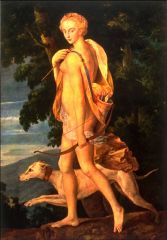
School of Fontainblaue
Diana the Huntress |
|
|
What is the myth?
Callisto was a nymph (or, according to some sources, the daughter of Lycaon) who was associated with the goddess of the hunt, Artemis. Young women who were devoted to the goddess hunted with her regularly, and remained virgins, like Artemis herself. Callisto had upheld these ideals faithfully, and she quickly became Artemis' favorite. While Callisto spent her days and nights with Artemis' other followers, she caught the eye of Zeus. Knowing that the maiden had taken a vow of chastity, Zeus resorted to deception to get at Callisto. He came to her disguised as Artemis, and the young huntress let down her guard. Seizing the opportunity Zeus raped her. Callisto became pregnant, and tried desperately to conceal her condition form the goddess. After all, she had, in a way, broken her vow to the goddess and she feared her anger. Callisto had been successful for a time, but then a day came when all of the young women who followed Artemis disrobed to bathe together in a spring. By now Callisto was beginning to show, and once she was naked her secret was revealed. Artemis was furious and she banished the young woman from her fold. Callisto wandered off to have her child alone. Hera decided that this was the time to exact her revenge. She gripped Callisto's hair and threw her to the ground where the new mother was transformed into a bear. The hunter became the hunted. The child that Callisto had by Zeus was spirited away by Hermes to be raised by his mother, Maia. He was named Arcas, meaning "bear," and he grew up to be a fine hunter himself. Some sources have the bear captured and taken to Callisto's own father, Lycaon. According to some sources Artemis herself killed the bear that was once Callisto, but it is usually accepted that when Arcas was out hunting as a young man he encountered the bear. Callisto recognized the handsome youth as the son she could not raise herself. Forgetting her present form, she tried to come near him, but her loving mother's arms were now strong, furry paws, and her once soothing voice was now a rumbling growl. The bear scared Arcas, and he took aim at her with his spear. Zeus took pity on his former victim and intervened. He placed Callisto in the sky as the constellation Ursa Major, or "great bear," and then took Arcas and placed him in the sky near his mother as Ursa Minor, the "little bear." Hera was not pleased with this arrangement, especially since Callisto was another of her husband's infidelities. She went to her nurse, Tethys, the wife of Oceanus, and beseeched her to punish Callisto and Arcas. Tethys decided to deprive the pair of water, and so the great bear and the little bear are cursed to circle in the skies, never to dip below the horizon for a refreshing bath or a cool drink. Here the peoples of ancient Greece explained why the two constellations are circumpolar, visible all year round. |

Boucher
Zeus and Calisto |
|
|
What does he do to Diana that he does characteristically in his art?
•Hunting dog •What are they doing? •Bathing (washing feet) •Thistle •Crescent moon •Contemporary scene of his time (Dutch) •Quiet/everyday scenes •Restrained |
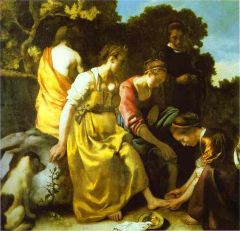
Vermeer
"Diana and her Companions" |
|
|
What does the emblem in the hair do to the picture? Conisder the punch as well as the character of Diana and this lady.
•Mme. Virginy Gertreau Thought to be daughter of planter (in Paris all southern France people were planters) •Eccentric, artificial beauty •Showed a desire to painter her portrait •Restless sitter •Not a pretty painting, striking thought •*look this up online •part sexual predator •power of skin rising above décolletage •suggestion that she was no better than she had to be •undercurrent of French anti-Americanism, •opposed art for arts sake doctrine of the time, extreme aestheticizing of her •why are we looking at her? oMoon on brow oTaking a seductress back to a virgin state…. oArtemis like majesty, but she’s a seductress oPose a composition oProper in gown oLike Madonna, what she projects is a persona |
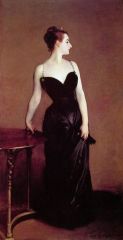
Sargents
Madame X |
|
|
Something is done here to show us the significance of the characters. A trick of composition and way of assembling the picture. What is it?
•Utterly beautiful •Even mythically ugly characters are painted beautiful •Put a cupid in for no reason, obviously cupid wouldn’t help at this point •Narcissus up front, lying down in stupor, narcotic state •On a rocky ledge, pool at bottom, obligatory to story •Flowers at head…when his soul passes he’s transformed into the Narcissus flower, they become him, he becomes them •Echo leaning against rock in back •Disappointed look, sitting on a rock, turns into an insensitive, unfeeling rock…legs disappearing, her outline doesn’t really rise out of the rock she’s turning into •In a triangle, no report, no closeness, laid out in a scattered fashion, cupid removed, everyone is looking away from everyone else •No love this time •Tree is commenting on the tragedy, separation •Good depiction of alienation |
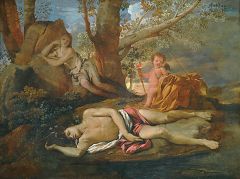
Poussain
Echo and Narcissus |
|
|
What process or theory is criticized in this picture and for what reason?
•Water like in myth •Reflective in both ways •Narcissus flower coming out of egg thing •On the left, head resting on knee •On the right, egg is resting on…? Transformed oStone hand! Rises out of reflection oHe’s become the stone that is behind the body on the left oSucked up and become the echo figure •Up on a pedestal on the right •gazing down, admiring at himself •critical of psycho-analysis •brought painting to show Freud •the hand is psycho-analysis •immobilized in stone, egg burst forth in flower, the self •people dancing, dance of life •apart from the dance of life |
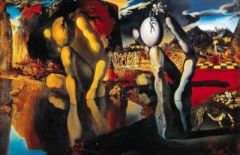
Dali
Narcissus |
|
|
Boyd
"Cave Narcissus and the Orange Tree" *no pic* |
Saylor put it up to show us that we don't need a bottom line for everything. There is an orange tree on the left reflecting the story of Narcissus. His face is primal making him a transitional character not quite man and not quite ape. He, and the ragged bird on the left, are moving from left (torn up) to right (beautiful) in the picture. It is a hard task, but it must be done. We're not sure, however, whether or not this is a good journey, but we think its good. Also, what I think is probably most important (this was a really weird picture and no one said anything about it...random.) is he said that not only animals live in caves, but people who want to get away from society--- this is interesting due to the complex civilization portrayed in the background.
|
|

Jordans
"Atalanta and Meleager" Have 2 pics, not sure which one is right? Include both |
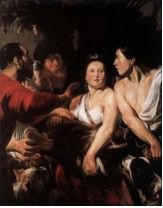
What moment is this in the myth and why does the artist pick it?
Atalanta has just been awarded the boar's head that she won by striking it first in the hunt (she was the only woman allowed to hunt only because Meleager admired her hunting skills). Meleager and her are in love which is portrayed by the lightness of the two figures. However, Meleager's uncles are disgruntled and... "chapped" in the background becuase of Atalanta's success. They are depicted in the darkness- the evil that is about to occur. This is the moment where Meleager's uncles are about to start a fight--- Meleager is drawing his sword. He's painted the drama and the tragedy of the evil that is about to happen. A decisive moment of suspense. |
|
|
Here the message is that the contention between people is often caused by selfish purposes of those people. Atalanta wants the apple Meleager has dropped for her, and Meleager wants to win the race. There is no love here, only contention- its antagonistic. The crossing of their bodies symbolizes the crossing of their purposes. There is also a lot of forboding as seen in the overcast sky.
|
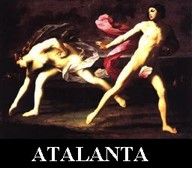
Reni
Atalanta and Meleager |
|
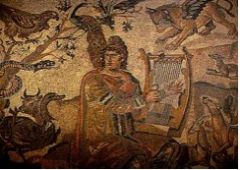
Roman Mosaic/Odalisque by Ingres
A & B |

The Two are shown together to portray the charming effect and the power of music. Music places you in your own tame work and places you in the presence of yourself and your spirituality. You can tame and charm the world with the power of music.
•How do you paint music? •Shut off world, balcony that you can only get in through opening •Suggests closed, restricted, exclusive world •Can’t get in there because there is a Nubian slave •Hookah pipe, indicates the concentration, closed circuit of subjects mind |
|
|
•Features of man, animal, music, different than what we find in the Orpheus tradition, Associated with primitive viewpoint, Snake charmer?
•How is this related to Orpheus? How is it the same, how is it different? oHe plays music oCharming wild creatures •How is this unlike the usual Orpheus representation? oSet out in the wild •Relationship between man, music, animal? oWhat is the mood of this picture? oHow do you know? oThis guy blends in to the scene, orpehus standso out more oThis guy is almost half animal oControlling the animals oSo they don’t bite him |
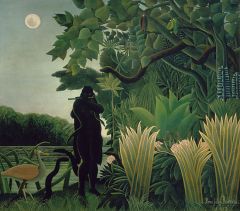
Rousseau
Snake Charmer, Orpheus |
|
|
•What has replaced music?
•Man represented by girl in the middle •Issiah, taming of animals? •Music of Orpheus translated into the love of Jesus •Where’s the music? |
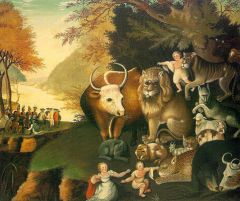
Hicks
Peaceable Kingdom |
|
|
•What is the attitude, frame of mind of Ares? One thing that conveys the attitude
•Certain mood, frame of mind •Bed clothes draped on him like a diaper, looks like a baby •Almost feel sorry for him •Total reduction |
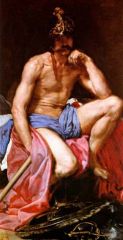
Valasquez
Ares (Mars) |
|
|
•Sensual composition
•What conveys the message, what is that central thing in the way the picture is painted that helps convey the meaning? •Allegory •Depicts Roman tendency to violence and war •Aphrodite w/Putti •Ares, sword in hand, armor (lover of Aphrodite) •Being dragged forward by a Fury (Allecto) •Hardly any time the Roman’s aren’t at war •Reuben’s using myth to discuss Europe of his own day •Allegorizing the victim, Europe, of Reuben’s time •Contemporary Europe with Ancient Rome •Temple of Janus…2 faced God, forward and backwards oGod of Doorways •Whenever Rome was at war the gates to the temple of Janus are flung open, let out spirit of Janus, the war would go well •Spirit of Janus is spirit of beginning, starting, thresholds •The best arts, the liberal arts, get down trodden by the impulse towards war •General’s always wore scarlet cloaks so could be seen •Scarlet cloak worn by Ares to symbolize blood, sword is bloody •Aphrodite tries to drag him back towards love and peace •Picture of tension, fury and war pulling toward right, Aphrodite pulling to the left •Gash through the whole picture •Tension between birth, procreation, good fertility and WAR •No reuben’s look |
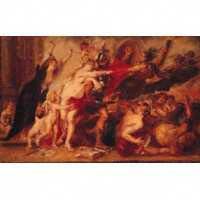
Ruben's
Horrors of war |
|
|
•2 things Poussain is talking about, as he looked at the Romans, what are they and how are they expressed in the piece?
•Rome is younger civilization, no women •Invite women, no one comes for drinks •Invite Seybines over for games, steal their women, run behind walls of Rome •Clever movement oCentrifugal….movement is apart, expanding •Paint picture of roman expansion through it’s militarism •Architecture is going up, verticle, Romans are rising •Political, business buildings |
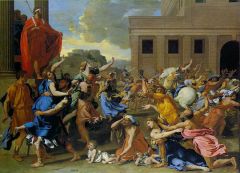
Poussain
Rape of the Sabine Women |
|
|
•Message of picture and any one thing that conveys the message, supports the message or significance?
•French Nationalism •What is some of the artistry in this? •How does he paint loyalty, bondage with another in true faith? •Father holding swords up in air in center, main focus •All 3 brothers together, holding one another •What else enhances the uprightness, valor of these individuals? oPillars, archways •Soft colors that they are wearing as opposed to brightness and steel of gun metal •Can see how the painting implies children •….horizontal implies women, represent the homefront |
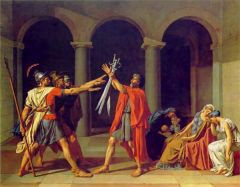
David
Oath of the Horatti |
|
|
•How is this a reversal or how is it different from the way David usually conceptualizes Roman myth
•Vs. Oath…? What does he usually feel/express/use the roman myths for, how is this a turnabout? •Unheroic feel because of the women oWomen say stop fighting because either way they lose their families •Goes against whole concept of heroism, valor •Normally in David’s work women are off in corner, quiet note of sentimentality •Way out women’s sphere in this one |
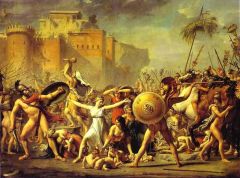
David
Sabine Women |
|
|
Lotto, "Lucretia"
Hopper "Sunlight in a Cafeteria" A & B |
•Why did we show you picture B with respect to picture A?
•What were we illustrating in Picture B that’s true in A? •Looks like she gets around •Ripped dress, tailored ripping, the ripping of rape •Baby cradle •Cut flower, represents deflowering something •Because of her attractiveness, maybe someone has charged her for being the kind of woman that she dresses like •Taking a position of absolute defiance of that •If you push me far enough, you’re pushing me in the direction of someone who died for chastity •But baby bed? •Sort of jammed in a corner, put on the spot •Between charged with a lack of chastity and motherhood •Depiction of mental states, social vs. spiritual compare with… Hopper, Sunlight in a Cafeteria •To him, cities become alienated in cities, become walled off •Use of barrier to make a statement •They are fixed in place by the tables •Paralyzes them, immobilized |
|
|
•Describe the line of force or energy or feeling in this picture?
•If you were to draw a line it would go from where to where, the line would indicate force/energy/what people would intend (she’s pulling at him) •Dogs facing direction of the hunt •Putti also pulling at him to stay •Woods on the right are dark…..but you’d think the dangerous part would be on the other side •Line goes from top left to bottom right •Interested in flesh •His being bled over with the crimson of the hunt •Horn coming out of his side •No eye contact, opposite of Reuben’s gaze •Discarded for effect |

Reuben's
Venus and Adonis |
|
|
•What was he trying to portray?
•Main feeling •She just looks like a regular woman, not like a God •Sentimental •Putti is also mourning •Engages you in the mourning |

West
Venus Mourning Adonis |
|
|
•What is the impression you get about Venus, one thing and why?
•Dog looks evil •She’s not sitting in his lap •2 people you’re not supposed to like •is that a TV camera? •What about his boot? oFancy boot to go hunting in oGoing hunting in red? Not very camo •Not supposed to like anyone in this pic, he vulgarizes in his own way |
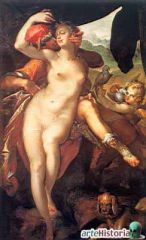
Spranger
Venus and Adonis |
|
|
•Kills his wife accidentally with a spear throw
•What is the main feeling in this picture? One reason why, one way that feeling is expressed? •Procris comes home to her husband •Husband, gifted hunter, depicted like a saytr….so immersed in wild woodland life that he has sharp ears, much like a woodland creature himself •Has killed his wife, nothing he can do about it •What is the artist interested in conveying? Why? oThe lines are all very horizontal oHow do they frame it up? oHorizontal, flat dead, picture is death |

Di Cosimo
Cephalus and Procris |
|
|
•What is the meaning of this picture and one reason why? What is the picture expressing?
•Hint: geography •River of death •Statement about what hell is •Death is here and now •Geography of death is our geography of death •What are we leaving? Where is the good side… oLeft side….pretty place oGoing toward darker place oWar is hell….war going on on right oFire, smoke |
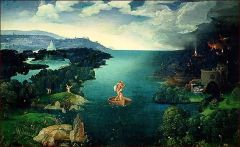
Patinir
Charon Crossing the Styx |
|
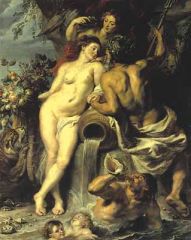
Reubens, Union of Earth and Water (A)
El Greco, Apostles Peter and Paul (B) |

•Why was B show in relation to picture A?
•What does B help illustrate, explain about picture A? •HANDS •Sort of marriage in universe •Illustrating union of male (water) and female (earth) •Personifying Poseidon (Neptune) oHad a crown and trident •She is fertile, she is holding the foliage •Makes everything blossom •Tiger on left, feline representation of lust •Male god of marriage is called Hymen, giving secular blessing to union of male and female •Male is muscular, tan •Triton using conch to call •Marital union produces children….water putti •Women as container that brings forth things •Kids aligned with….water breaking •Shells often a suggestion of female genitals •Then the spear becomes phallic •What is dead center? The hands… B •Paul on right, very into whatever he believes, more outgoing •More passionate of the two because of the red cloak, •Show hands •Paul has a finger on the text •Evocative of a lot of energy and drive •Need aspects of both guys, impulses, to run a church |
|
|
•What is the philosophical meaning of Venus in this picture?
•birth of soul, generated at the will of god, born of the sea •sea=infinity •pushed to land by nymph, wind god •man + woman, need that form of purpotion to bring beautiful soul to rest in the world •when it gets to the world it’s too beautiful to be seen by human kind •Neo-Platonism •An allegory •Gets the mortal mantel that is the body •A personification of spring, seasons, it’s a nymph (on right) representative of the passage of time that cloaks this soul in it’s mortal shell •Icon of beauty, idealized form of truth and beauty •? how is the birth of venus, Aphrodite, being used |
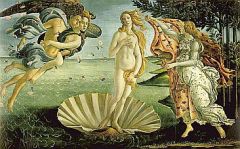
Boticelli
Venus |
|
|
Where is he trying to put you in this picture? Why?
•fleshly female showing sexual abandon, luxuriating in her own voluptuousness •how does he engage you? Where does he put you? •You are the satyr, playing a game with you, playing on male audience •Satyrs are creatures that express lust •What is the satyr doing? Being a peeping tom |
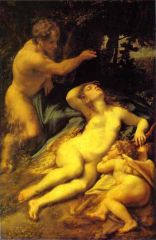
Corregio
Venus and Saytr and Cupid |
|
|
How is this Venus and innovation on/different from the Venuses in the tradition?
•Alter piece illustration •Nothing else going on •Very different from other ones •Archetypal pose •Looks sad and tired •Not very abstract •Strong, muscular being whose look is a challenge to regular man |

Di Credi
Venus |
|
|
What’s the meaning of this depiction? What’s the meaning or significance of the way she is illustrated here?
•“without Baccus and Cerese, venus is cold” •bacchus=wine, cerese= cereal •what happens to Venus without bread and wine •symbolic of what you need to keep warm •love goes out to another, exactly what she is not doing, all turned upon herself •instead of longing for somebody else, she’s not even looking at them, shivering cupid, Bacchus looming in back •does not blame Venus, explains this is our conditions, body and soul are too intimately united to function separately •love does not function in a vacuum •“material girl” •love is 7 days a week, requires the basic requirements |
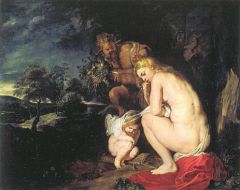
Reubens
Venus Frigida |

